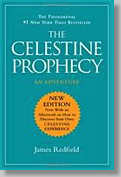"If one tells the truth, one is sure,
sooner or later, to be found out."
-Oscar Wilde
|
|  
 
|  Mystics and mysticism have long been misunderstood. There's something in the words that conjure images of secret rituals conducted out of sight of mainstream faith. But in fact, mystics and their practices are found in virtually every religious tradition known to man. Andrew Harvey, author and founder of the Institute of Sacred Activism in Oak Park Illinois, is no stranger to mystics. He sees them as having one goal in mind: to be as one with reality. Not the illusion we often mistake for reality, but reality itself. Isn't that the aim of every faith, to achieve oneness with the Creator by getting in touch with the spiritual reality that imbues all things?
With a cover reminiscent of Hal Lindsey's 1970 edition of The Late Great Planet Earth (Zondervan, $17.99), The Hope: A Guide to Sacred Activism by Andrew Harvey, like Lindsey's book, deals with apocalyptic themes. But that's where the comparisons end. Whereas Lindsey's title paints a doomsday scenario there is no physically escaping, Harvey's does not. Rather, Harvey's, as suggested by its title, offers hope.
Religiography
While the term Sacred Activism may not be a familiar one, many uninitiated are surprised to learn they are already partly, or fully engaged in it. Sacred Activism is good works, toward the goal of healing our planet. It may be a volunteer activity you're already involved in. Or, it may be a new calling. It encompasses any activity performed with the intent of healing, helping, or otherwise furthering the advancement of humanity. It may be as simple as tutoring a young reader, or as complicated as housing the homeless. Above all, Sacred Activism is defined as an act that puts Divine Love into action.
Love Connection
Today, with the financial crisis in the rear view mirror, and seeming to pale in comparison to current crises competing for our attention (J6, the ongoing pandemic, war in Europe, climate change), The Hope remains an important read. While Harvey's concepts may be difficult to grasp for newbies unversed in the terminology of Eastern traditions (for that there's a glossary), the hope provided by the author is not. In the words of the late, great gay rights activist Harvey Milk, "You gotta give 'em hope." It's as simple, and complicated, as all that.
James Redfield's The Celestine Prophecy serves as a great example of what can be accomplished with allegory. Like Andrew Harvey (The Hope: A Guide to Sacred Activism, Hay House, $16.95), he's peddling his vision for the future of humanity and how to reach it. Unlike Harvey, he couches it in adventure.
Prophecy starts out a little slow. The set-up feels a bit contrived, the conversation stilted, coming off like it were torn from the script of a Hallmark Channel infomercial, if the Hallmark Channel had such things. After six years of absence, our protagonist (we'll call him James, since it's written in the first person) is contacted by his old friend Charlene. Their meeting is simply a tool for setting up the story, and it shows. She wants to fill him in on an ancient manuscript she's been pursuing, and proceeds to do so with all the gusto of discussing the latest fad in non-stick cookware. Every line sets James up to ask the precise question that will lead him to the next set-up. The only thing missing is a voice-over shouting, "Get two for the price of one; just pay an additional handling fee!"
As could be predicted, James takes the bait. Within a few days he's galavanting through Peru on a mission to find the manuscript, barely avoiding capture (the Peruvian authorities are in cahoots with the Catholic Church to keep it under wraps) while coincidentally - a big theme in Prophecy - meeting all the right people at all the right times to advance him in his quest. And the manuscript begins to manifest itself. Not at once, but in pieces, adding layer upon layer to the metaphysical puzzle that keeps the pages turning.
This series from Time-Life, covering all things mysterious from lost civilizations to alien visitations, has a reputation for hitting its mark with an authoritative, yet easy-going, editorial style that avoids the weeds.
Not all the places covered in Mystic Places are physically tangible. The Lost continent of Atlantis, is one such place, as is the Lost City of X, a South American metropolis rumored to have been colonized by Atlanteans in ancient times. Numerous explorers have met their ends in search of it. Troy, of Trojan fame, was long thought to fall into the category of myth until 1873 when an amateur archaeologist convinced Homer's Iliad was a historical account, uncovered its remains beneath Hissarlik, Turkey. The discovery keeps the flame alive today that other legends, long considered myth, are waiting to be discovered.
Speculation
While stories about mythical places capture the imagination, so do theories about places that are real. Of those, perhaps Egypt's pyramids and Stonehenge are most pervasive. The pyramids, at one time or another, have thought to have been grain storage silos, temples, tombs, even a mammoth astronomical map, among other things. It seems with each generation of explorers comes a new theory. Stonehenge, that famous megolithic stand of rocks on England's Salsbury Plain, too has had its share of theories as to its purpose and construction. One theory that stood for a long time had it that the stones originated in Ireland and were "flown" to where they stand now by the great magician Merlin. In keeping with this theme is the theory that Stonehenge had a function in King Arthur's court.
Proof
Though the sites investigated in Mystic Places are intriguing, they're also incomplete. Without a clear understanding of their purpose (why did primitive cultures carve figures into the earth that can only be appreciated from the air?) they lack meaning. While mystic they may be, that means nothing without knowledge of the mysticism that inspired them; the ritual that gives them purpose. Without it, they remain cold, lifeless blocks of stone, mere elipses on the historical plane, however visually impressive they may be. Illustrated.
posted 03/03/22
 TOP | NEXT |


